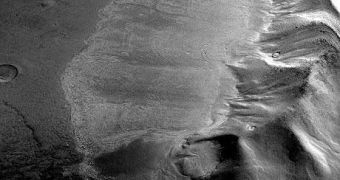The mild slopes on the mid-latitudes of Mars were first spotted by the Viking orbiters during the '70s and their composition has eluded the scientific world so far, given the differences in aspect when compared to the surrounding similar features. But recent observations by NASA's Mars Reconnaissance Orbiter (MRO) helped a team of researchers led by John Holt from the University of Texas determine that, in fact, they are large buried chunks of ice.
The Shallow Radar instrument aboard the MRO indicated that the layers beneath the surface were actually pure ice. Extrapolations on the findings hinted to the presence of a massive amount of such glaciers which normally should not be there, at the low latitudes of the Hellas basin area. This leads the experts to conclude that the planet may have changed its orbital tilt in time, allowing for the occurrence of multiple ice ages, affecting various regions.
Naturally, it should have turned directly into gas when the tilt changed to what it is today, but the fact that the glaciers are buried prevented this from happening. By counting the amount of craters in the region, the specialists were able to date their age to about 100 million years.
Upon freezing, the glaciers' water may have also enclosed within itself tiny bits of the atmosphere or organic compounds of that time, which the experts are eager to find. "On Earth, such buried glacial ice in Antarctica preserves the record of traces of ancient organisms and past climate history," explained Jim Head from Brown University, Rhode Island, quoted by Space.
Also, such large features contain vast amounts of water which could support the future human colonies on Mars for a long time, although the equatorial glaciers represent only about 1% of the ice found at the polar caps of the red planet.

 14 DAY TRIAL //
14 DAY TRIAL //